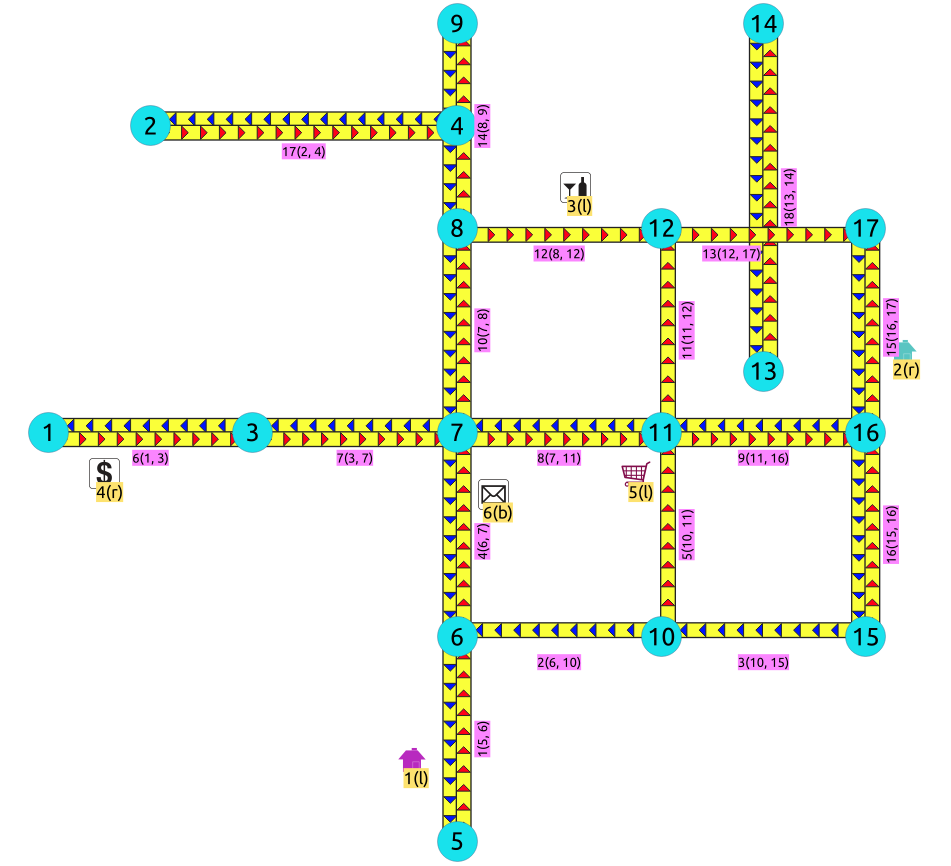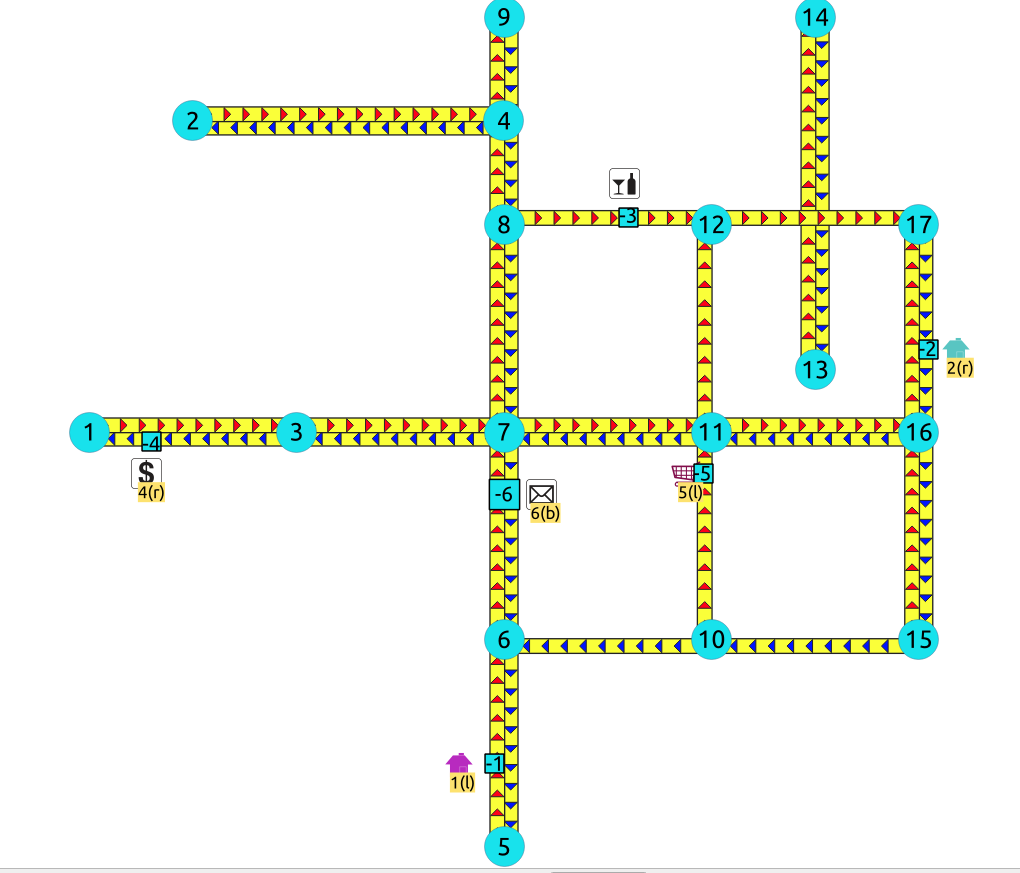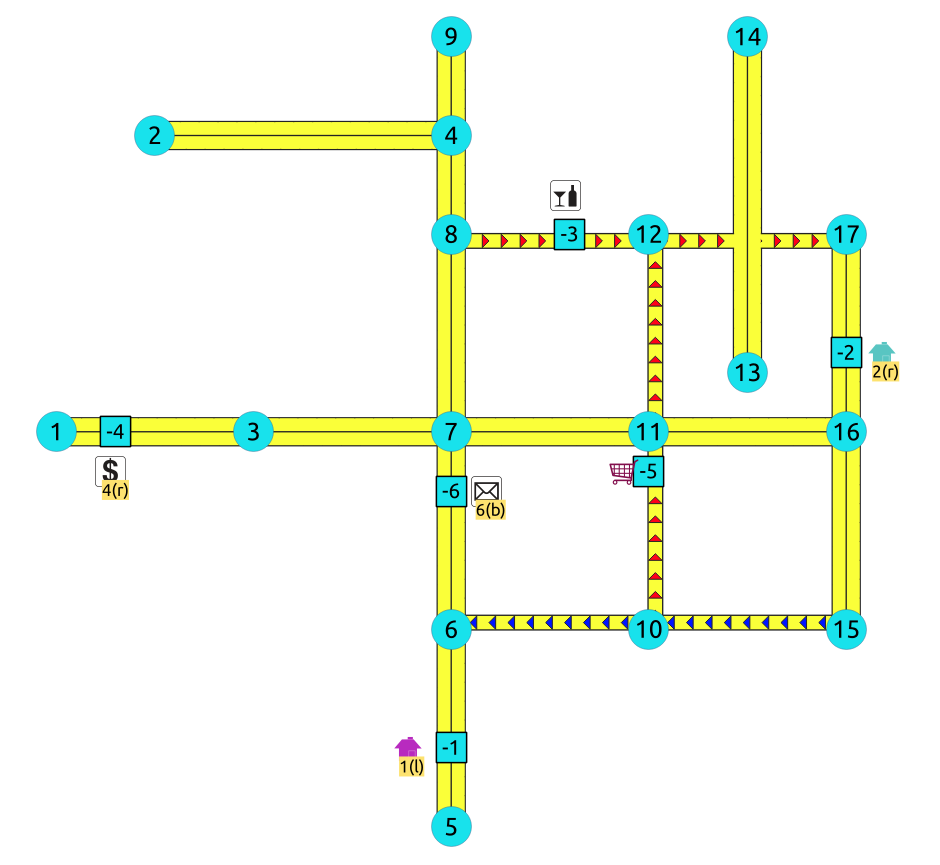Unsupported versions:2.6 2.5 2.4 2.3 2.2
withPoints - Family of functions¶
When points are also given as input:
Warning
Proposed functions for next mayor release.
They are not officially in the current release.
They will likely officially be part of the next mayor release:
The functions make use of ANY-INTEGER and ANY-NUMERICAL
Name might not change. (But still can)
Signature might not change. (But still can)
Functionality might not change. (But still can)
pgTap tests have being done. But might need more.
Documentation might need refinement.
pgr_withPoints - Proposed - Route from/to points anywhere on the graph.
pgr_withPointsCost - Proposed - Costs of the shortest paths.
pgr_withPointsCostMatrix - proposed - Costs of the shortest paths.
pgr_withPointsKSP - Proposed - K shortest paths.
pgr_withPointsDD - Proposed - Driving distance.
Introduction¶
This family of functions belongs to the withPoints - Category and the functions that compose them are based one way or another on dijkstra algorithm.
Depending on the name:
pgr_withPoints is pgr_dijkstra with points
pgr_withPointsCost is pgr_dijkstraCost with points
pgr_withPointsCostMatrix is pgr_dijkstraCostMatrix with points
pgr_withPointsKSP is pgr_ksp with points
pgr_withPointsDD is pgr_drivingDistance with points
Parameters¶
Column |
Type |
Description |
|---|---|---|
|
Edges SQL as described below |
|
|
Points SQL as described below |
|
|
Combinations SQL as described below |
|
start vid |
|
Identifier of the starting vertex of the path. Negative value is for point’s identifier. |
start vids |
|
Array of identifiers of starting vertices. Negative values are for point’s identifiers. |
end vid |
|
Identifier of the ending vertex of the path. Negative value is for point’s identifier. |
end vids |
|
Array of identifiers of ending vertices. Negative values are for point’s identifiers. |
Optional parameters¶
Column |
Type |
Default |
Description |
|---|---|---|---|
|
|
|
|
With points optional parameters¶
Parameter |
Type |
Default |
Description |
|---|---|---|---|
|
|
|
Value in [
|
|
|
|
|
Inner Queries¶
Edges SQL¶
Column |
Type |
Default |
Description |
|---|---|---|---|
|
ANY-INTEGER |
Identifier of the edge. |
|
|
ANY-INTEGER |
Identifier of the first end point vertex of the edge. |
|
|
ANY-INTEGER |
Identifier of the second end point vertex of the edge. |
|
|
ANY-NUMERICAL |
Weight of the edge ( |
|
|
ANY-NUMERICAL |
-1 |
Weight of the edge (
|
Where:
- ANY-INTEGER:
SMALLINT,INTEGER,BIGINT- ANY-NUMERICAL:
SMALLINT,INTEGER,BIGINT,REAL,FLOAT
Points SQL¶
Parameter |
Type |
Default |
Description |
|---|---|---|---|
|
ANY-INTEGER |
value |
Identifier of the point.
|
|
ANY-INTEGER |
Identifier of the “closest” edge to the point. |
|
|
ANY-NUMERICAL |
Value in <0,1> that indicates the relative postition from the first end point of the edge. |
|
|
|
|
Value in [
|
Where:
- ANY-INTEGER:
SMALLINT,INTEGER,BIGINT- ANY-NUMERICAL:
SMALLINT,INTEGER,BIGINT,REAL,FLOAT
Combinations SQL¶
Parameter |
Type |
Description |
|---|---|---|
|
ANY-INTEGER |
Identifier of the departure vertex. |
|
ANY-INTEGER |
Identifier of the arrival vertex. |
Where:
- ANY-INTEGER:
SMALLINT,INTEGER,BIGINT
Advanced Documentation¶
About points¶
For this section the following city (see Sample Data) some interesing points such as restaurant, supermarket, post office, etc. will be used as example.

The graph is directed
Red arrows show the
(source, target)of the edge on the edge tableBlue arrows show the
(target, source)of the edge on the edge tableEach point location shows where it is located with relation of the edge
(source, target)On the right for points 2 and 4.
On the left for points 1, 3 and 5.
On both sides for point 6.
The representation on the data base follows the Points SQL description, and for this example:
SELECT pid, edge_id, fraction, side FROM pointsOfInterest;
pid | edge_id | fraction | side
-----+---------+----------+------
1 | 1 | 0.4 | l
2 | 15 | 0.4 | r
3 | 12 | 0.6 | l
4 | 6 | 0.3 | r
5 | 5 | 0.8 | l
6 | 4 | 0.7 | b
(6 rows)
Driving side¶
In the the folowwing images:
The squared vertices are the temporary vertices,
The temporary vertices are added according to the driving side,
visually showing the differences on how depending on the driving side the data is interpreted.
Right driving side¶

Point 1 located on edge
(6, 5)Point 2 located on edge
(16, 17)Point 3 located on edge
(8, 12)Point 4 located on edge
(1, 3)Point 5 located on edge
(10, 11)Point 6 located on edges
(6, 7)and(7, 6)
Left driving side¶

Point 1 located on edge
(5, 6)Point 2 located on edge
(17, 16)Point 3 located on edge
(8, 12)Point 4 located on edge
(3, 1)Point 5 located on edge
(10, 11)Point 6 located on edges
(6, 7)and(7, 6)
Driving side does not matter¶
Like having all points to be considered in both sides
bPrefered usage on undirected graphs

Point 1 located on edge
(5, 6)and(6, 5)Point 2 located on edge
(17, 16)``and ``16, 17Point 3 located on edge
(8, 12)Point 4 located on edge
(3, 1)and(1, 3)Point 5 located on edge
(10, 11)Point 6 located on edges
(6, 7)and(7, 6)
Creating temporary vertices¶
This section will demonstrate how a temporary vertex is created internally on the graph.
Problem
For edge:
SELECT id, source, target, cost, reverse_cost
FROM edges WHERE id = 15;
id | source | target | cost | reverse_cost
----+--------+--------+------+--------------
15 | 16 | 17 | 1 | 1
(1 row)
insert point:
SELECT pid, edge_id, fraction, side
FROM pointsOfInterest WHERE pid = 2;
pid | edge_id | fraction | side
-----+---------+----------+------
2 | 15 | 0.4 | r
(1 row)
On a right hand side driving network¶
Right driving side

Arrival to point
-2can be achived only via vertex 16.Does not affects edge
(17, 16), therefore the edge is kept.It only affects the edge
(16, 17), therefore the edge is removed.Create two new edges:
Edge
(16, -2)with cost0.4(original cost * fraction ==Edge
(-2, 17)with cost0.6(the remaing cost)
The total cost of the additional edges is equal to the original cost.
If more points are on the same edge, the process is repeated recursevly.
On a left hand side driving network¶
Left driving side

Arrival to point
-2can be achived only via vertex 17.Does not affects edge
(16, 17), therefore the edge is kept.It only affects the edge
(17, 16), therefore the edge is removed.Create two new edges:
Work with the original edge
(16, 17)as the fraction is a fraction of the original:Edge
(16, -2)with cost0.4(original cost * fraction ==Edge
(-2, 17)with cost0.6(the remaing cost)If more points are on the same edge, the process is repeated recursevly.
Flip the Edges and add them to the graph:
Edge
(17, -2)becomes(-2, 16)with cost0.4and is added to the graph.Edge
(-2, 16)becomes(17, -2)with cost0.6and is added to the graph.
The total cost of the additional edges is equal to the original cost.
When driving side does not matter¶

Arrival to point
-2can be achived via vertices 16 or 17.Affects the edges
(16, 17)and(17, 16), therefore the edges are removed.Create four new edges:
Work with the original edge
(16, 17)as the fraction is a fraction of the original:Edge
(16, -2)with cost0.4(original cost * fraction ==Edge
(-2, 17)with cost0.6(the remaing cost)If more points are on the same edge, the process is repeated recursevly.
Flip the Edges and add all the edges to the graph:
Edge
(16, -2)is added to the graph.Edge
(-2, 17)is added to the graph.Edge
(16, -2)becomes(-2, 16)with cost0.4and is added to the graph.Edge
(-2, 17)becomes(17, -2)with cost0.6and is added to the graph.
See Also¶
Indices and tables
